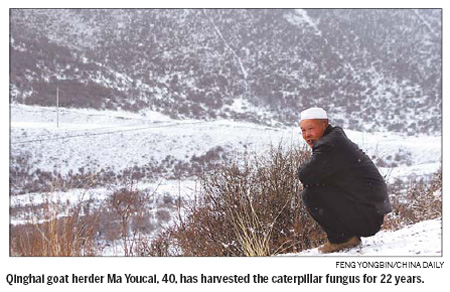Rare fungus faces extinction
 |
However, the industry also has a considerable impact on China's medicinal plants, which comprise the vast majority of its raw ingredients. (By comparison, just more than half of Western medicine uses chemicals derived directly from plants.)
The list of endangered plants in China includes licorice root, which is used to treat fatigue and pain; the Chinese yew, an evergreen tree believed to contain chemicals that can help prevent cancer; and wild ginseng, which is said to increase energy and improve circulation. Many other species are also in danger of simply being harvested out of existence to meet growing market demand.
"Originally, Chinese medicine was very localized. Of course, there was some trade, though it was not a lot," said Luo Peng, a professor at the Chengdu Institute for Biology. "But the scale of that trade grew extremely quickly along with domestic demand as China has become market-driven over the last 30 years."
The sector makes about 150 billion yuan ($22 billion) annually and is expanding at a rate of about 10 percent each year, said Long Xingchao, general manager of Tiandi Wang, a TCM website based in Chengdu, capital of Sichuan province. (He is not related to Long Chunlin).
China exports more than $1 billion in TCM annually and there are over 1,500 major suppliers across the country, he added.
"Standards of living (in China) have improved and per capita income has increased over the last 30 years. "People's demand for healthcare is stronger now and their awareness of healthcare issues is greater," said Zhao Yongwei, secretary general of the World Federation of Chinese Medicine Sciences.
As a result, more people now see TCM doctors about cures for chronic conditions they would not have been able to afford just a decade ago, including fatigue, indigestion, back and joint pain, and headaches. Consumption of new health products that include TCM has also increased. One example is Wang Laoji, an extremely popular herbal tea made from the honeysuckle flower, which generated over 10 billion yuan in sales revenue in 2008.
"It used to be that people were satisfied if they had enough to eat. Now they want to eat healthily, too," said Long Chunlin.
Strong government support for the sector and intensive research has also expanded the range of herbs and medicines available, and improved the quality of treatment, while China's aging population plays a role in the industry's growth as well, as elderly people often prefer TCM to Western medicine.
"Chinese medicine isn't for urgent medical issues. It's better for keeping you healthy overall. It's more comprehensive," said Chen Wei, a 34-year-old IT specialist who was visiting Beijing University of Chinese Medicine to seek treatment for eczema. He left the clinic with a prescription for a cocktail of herbs and was told to eat less spicy food.
Yet patients like Chen drive a supply chain that has dramatically reduced wild plant and herb populations across the country.
China uses 1.2 million tons of herbs in TCM annually, four times more than in 1975, according to a report published last December by zgycsc.com, an online traditional medicine market. Analysis in the journal HerbalGram also noted that, in 2007, the country exported 266,276 tons of medicinal plants at a reported value of more than $400 million.
Greater wealth has also led to a substantial growth in demand for remedies made from rare and expensive herbs or animal parts that are purchased for their social value, rather than medicinal value. The caterpillar fungus certainly falls into this category, said Fang Shaoxu, who manages a dongchongxiacao store in Xining, capital of Qinghai. "Most of our customers are relatively rich. They buy it for their business partners, bosses or friends, rather than themselves," he said.
"It is a vicious cycle," said Chengdu professor Guo. "These plants are expensive because they are rare, which leads more people to look for them and then the population drops even further."
A single jin - a Chinese measurement roughly equal to 500 grams - of caterpillar fungus can sell for up to 80,000 yuan, according to Fang. Consequently, for farmers, especially in remote and poor areas like Qinghai and northern Sichuan, the opportunity presented by medicinal plants and animals is irresistible.
"Most plants used in traditional Chinese medicine are found in areas that are not economically developed. Ordinary people there rely on them for their livelihood. This makes protecting the plants very difficult," said Guo.
Ma Youcai earned 3,800 yuan from the caterpillar fungus last year, about 40 percent of his annual income. Farmers often make an even higher portion of their income from harvesting medicinal plants in what scientists call the Upper Yangtze Eco-region, which includes most of Sichuan. The area produces about 75 percent of all commercially harvested medicinal herbs in China, according to research by TRAFFIC.
Such scavenging poses a danger not just to the plant populations themselves but also to their broader habitats, say experts.
In northwest Sichuan, villagers are now venturing into protected areas in and around the Wolong nature reserve - home to about 150 giant pandas - in search of medicinal plants to sell, said Xu Qiang, a senior officer at the World Wildlife Fund's (WWF) Chengdu office.
"The illegal collection of TCM plants is really a threat to the animals in the reserve," he said. "They not only collect the TCM plants and make these plants endangered, they chop down trees for heating and small huts, and poach small animals to eat."
 0
0 






